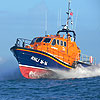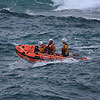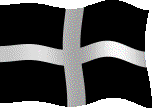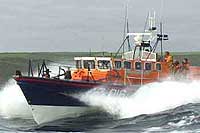





|

|

|
 |

|
| Sennen Cove All Weather Lifeboat |  |
Tyne Class "RNLB Norman Salvesen" |
|
The "Norman Salvesen" was placed on service at Sennen Cove in January 1999, having served for over 8 years at Wick , Caithness. The lifeboat replaced the Mersey Class "RNLB The Four Boys" which had been on station since 1991 , and is now serving at Amble, Northumberland. The Tyne Class Lifeboat is a 47 foot, 26 ton steel hulled self-righting lifeboat. The self-righting is achieved by the inherent buoyancy of the air contained in the superstructure, combined with the significant weight of the engines low in the boat......she simply cannot remain upside-down ! The vessel is powered by two GM6V92TA DDEC turbo-charged marine two-stroke diesel engines , each developing 525 horse-power ; giving the lifeboat a top speed of around 18 knots. Sufficient diesel fuel is carried for approximately ten hours duration at full speed ; though the duration is significantly increased if the engines are run at less than full speed (unheard of in lifeboats !!). The engines are computer-managed, with data being displayed on twin screens at both the Mechanic`s position and the Helm position in the wheelhouse.......yes, its fly by wire! Seated wheelhouse accommodation is provided for a crew of six, with an additional `jumper` seat for a doctor. Today`s lifeboats are sophisticated machines , and wheelhouse equipment includes satellite navigation equipment interfaced through a PC to a visual chart display. Daylight viewing radar is used both for navigation and to search for casualties. VHF radio direction-finding equipment regularly proves invaluable in locating boats in trouble ; and all lifeboats now carry the latest DSC digital radio equipment. Radio communication in any search and rescue mission is vital, and the lifeboat is equipped with three VHF radios (one portable) together with an MF `long range` set. Complementing the powerful searchlights, lifeboats are also now equipped with image-intensifying "night sight" equipment. People often ask how many survivors the lifeboat can carry. There are official figures based on the requirement for all persons to be strapped into seats (there are seats for survivors in the forehead cabin and the after cabin) and in that respect the Tyne can accommodate in the region of twenty survivors. In practice, however, particularly in fine sea conditions, the lifeboat can carry many more people , and there is a famous picture of the Tyne class lifeboat previously stationed at Ramsgate onto which Coxswain Ron Cannon had managed to cram in the region of 100 survivors from a ferry which had caught fire in the English Channel. A large amount of first-aid equipment is carried on the lifeboat, including both oxygen and entonox ; and the crew spend a considerable amount of time carrying out first-aid training. The Tyne Class Lifeboat was designed primarily to be launched from slipway stations , such as ourselves, The Lizard and Padstow in Cornwall. The Tyne also lies afloat at stations where the approaches , or operating areas , are particularly shallow . As the lifeboat `s propellors are protected by heavy bilge keels, she is particularly well suited to operate where there is a danger of hitting the bottom , or "tapping" as it is known locally. The risk of damage is much reduced , though before the e-mails start to flood in, we have recently proved that it is not eliminated !! |
| Sennen Cove Inshore Lifeboat |
| Home Page | Contact us | Lifeboat Home Page |